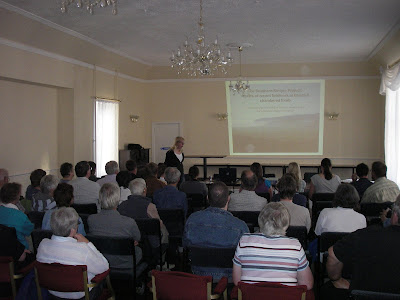


Well, this may well turn out to be the last post for a little while as we are gearing up to finish the dig and head for home. Backfilling has begun (I had the pleasure of filling and re-turfing the quarry trench myself yesterday) and it seems unlikely that we will make any more significant finds. Only one major question remains unanswered as I write, and that is where the original edge of the cairn ran at the eastern end before the 'horns' were added, which is looking like it may have been a surprisingly late date. The orthostats which make up the horn are placed on top of blocking material, which is on top of the courtyard paving, which was on top of the jet bead, which dates to around 2,000 BC, which is Bronze Age. This means that the monument was still being modified as late as 2,000 BC, which has taken everyone by surprise. If the early Neolithic pottery from the first phase was new when it was placed in the chamber it means that the monument was in use for over 2,000 years, which is a huge period of time. Of course, radio carbon dating may yet tell us another story. Another possibility is that the whole monument is Bronze Age, and the Neolithic material found is the product of a thriving Bronze Age antiques trade! No doubt other interpretations will also emerge in the following weeks and months as the material we are taking away with us gets analysed.
The public lecture in Campbeltown last night was a success, with an attendance of 34 people, and I would like to thank all who came. This brings the tally of people we have had direct contact with, either by delivering talks, displays or presentations, or by them visiting the site, to about 260, which is a great result.
I would also like to take the opportunity to thank the following people for thier help and support:
Angus Martin and Francis Hood
The Kintyre Antiquarian Society
Campbeltown Library
Muneroy Stores, Southend
Messrs MacCorkindale
National Lottery
Historic Scotland
And of course, Dr Vicki Cummings and Dr Gary Robinson, our dig directors who are responsible for creating this project and keeping it moving forward for the last 4 years. As Dr Henry Jones Jnr said, '90% of archaeology is done in the library' and so much of the work for this project has taken place in libraries, laboratories, amid hundreds of samples of quartz scattered across office floors and other such environments throughout the year by Vicki and Gary as well as actually out and about in Kintyre, and this work too often goes unrecognised.
This won't be the last entry in this blog. I will endeavour to post a few updates of the post-excavation work, but it will be the last time I sit in Campbeltown Library to do it for a while. I hope our readers have enjoyed the record of the dig, and am looking forward to hearing the results of post-ex and posting them to keep everyone up to date.













